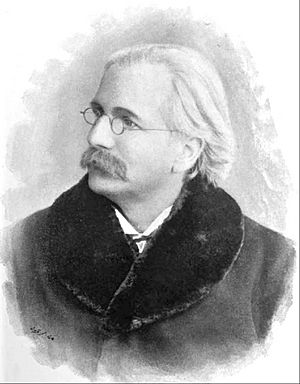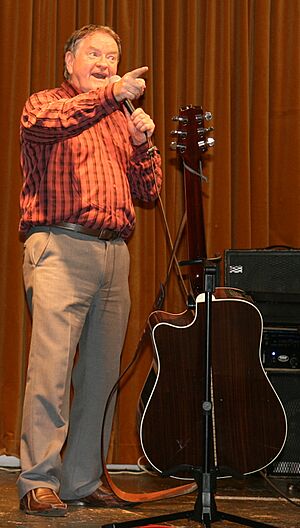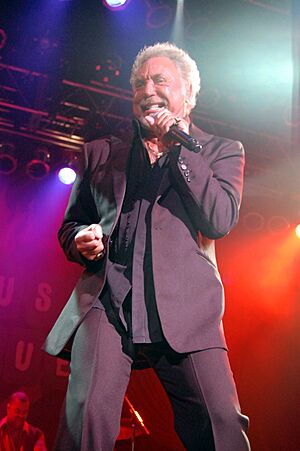Music of Wales facts for kids
The music of Wales is a super important part of what makes Wales special! People often call Wales "the land of song" because singing is such a big part of its culture.
While this idea became really popular in the 1800s and 1900s with amazing choirs and big singing events like sports matches, Wales has always used music to tell stories and share feelings. From old folk tunes to modern rock bands, Welsh music is a vibrant mix of sounds. Today, you can find everything from traditional folk and powerful choirs to rock, pop, jazz, and electronic music. Cities like Newport and Cardiff are especially known for their lively music scenes, with many places to see live bands!
Contents
A Look Back: Music Through History
Early Sounds and Traditions
Wales has a rich history of folk music, similar to the Celtic music you might hear in Ireland or Scotland. This music often features unique instruments and song styles. You might hear it at a twmpath (a fun folk dance party), a gŵyl werin (folk festival), or a noson lawen (a traditional party with music and stories).
Long ago, music was a main way people communicated in Wales. Ancient texts, like the Robert ap Huw Manuscript from the 1600s, show that Welsh music had complex harmonies even centuries ago. Some of the oldest songs are linked to yearly celebrations, like the Mari Lwyd or Calennig on New Year's Day, which involved special songs and dances.
For many years, traditional Welsh folk music faced challenges. Laws that promoted the English language and the rise of the Methodist church in the 1700s and 1800s changed how people thought about music. The church encouraged hymn singing and sometimes discouraged traditional dances, though folk tunes were sometimes used in hymns. However, Welsh poets and musicians have kept a tradition alive since the 1100s: musical and poetry competitions called eisteddfodau. These are like big talent shows for traditional arts!
Music and Community: The 18th and 19th Centuries
Welsh music is famous for its male voice choirs, like the Morriston Orpheus Choir and Treorchy Male Voice Choir. These choirs are known worldwide! This tradition is especially strong at sporting events, particularly rugby. In 1905, Wales made history when its national anthem, Hen Wlad Fy Nhadau, was sung before an international sports game for the very first time.
During the 1700s, a religious movement called Welsh Methodist revival greatly influenced music. It led to a focus on singing hymns together in churches. Writers like William Williams Pantycelyn helped make these hymns popular. People started forming local music groups, and by the mid-1800s, songbooks were printed and shared. This led to the Cymanfa Ganu, which are big festivals where everyone sings hymns together.
In the 1860s, people started to bring back traditional Welsh music. Groups like the National Eisteddfod Society were formed, and in the 1890s, Nicholas Bennett published Alawon fy Ngwlad ("Tunes of my Land"), a collection of old Welsh tunes.
From Choirs to Concert Halls: The 19th and 20th Centuries
The Victorian era saw the rise of brass bands, especially in the South Wales Valleys. Welsh bands, like the Cory Band, became some of the best in the world!

While much of the music in the 1800s was religious, composers like Joseph Parry also wrote many popular songs that weren't for church. His song Myfanwy is still a beloved Welsh tune today. Male voice choirs, which often started in chapels, also began singing these secular songs for fun and friendship outside of church. Wales also became known for amazing solo singers like Robert Rees and Sarah Edith Wynne, who performed all over the world.
In the 1900s, Wales produced many famous classical and opera singers, including Bryn Terfel, Gwyneth Jones, and Katherine Jenkins. Composers like Alun Hoddinott and Karl Jenkins also gained international fame. The Welsh National Opera, started in 1946, and the BBC Cardiff Singer of the World competition, which began in 1983, helped show the world how talented Welsh musicians are.
Modern Beats: Music After World War II
After World War II, two important music groups were created: the Welsh National Opera and the BBC National Orchestra of Wales. These groups encouraged Welsh composers to write more music for instruments and orchestras.
The 1900s also saw many Welsh singers become national and international stars. Ivor Novello was a popular singer-songwriter during World War I. Later, in the 1960s, Tom Jones and Shirley Bassey became huge global sensations, defining a unique Welsh singing style for many years.

The 1960s were an exciting time for both Welsh and English language music in Wales. The BBC started TV shows like Hob y Deri Dando to showcase Welsh performers. American and British pop music also became very popular, with Welsh artists like Mary Hopkin and Badfinger joining famous record labels. In 1967, Y Blew became the first Welsh language pop band, and in 1969, the Sain record label was founded, which was a huge step for Welsh language music.
In more recent times, the Welsh music scene has continued to thrive. Bands like Man and Budgie were popular in the 1970s, followed by solo artists like Bonnie Tyler and Shakin' Stevens in the 1980s. The Welsh language music scene also saw new and experimental bands like the punk group Trwynau Coch. Famous radio DJs like John Peel even played Welsh language music to a wider audience.
The 1980s and 1990s brought a boom in rock music, especially in Newport, which was sometimes called 'the new Seattle'. Bands like Feeder and Skindred came from this area. Many famous musicians, including Oasis and Kurt Cobain, even visited local venues like TJ's.
The 21st Century Sound
The early 2000s saw a distinct Welsh 'sound' emerge, loved by people across Great Britain. Bands like the Manic Street Preachers, Stereophonics, Catatonia, and Super Furry Animals became very successful. Even if they didn't always sing in Welsh, they brought a strong sense of Welsh identity through their songs and style. Some bands, like Super Furry Animals, even introduced Welsh language songs to a wider British audience. Today, the Cardiff music scene is still buzzing, earning the city the nickname 'Music City' for its many live music venues.
Different Kinds of Welsh Music
Traditional Folk Sounds
The harp is often seen as the national instrument of Wales. The traditional Welsh harp is called the telyn deires, or "three-row harp," which has three rows of strings! A special way of singing poetry with the harp is called penillion, where the singer and harpist play different melodies that fit together perfectly.
The oldest written music for the Welsh harp is found in the Robert ap Huw manuscript, which contains pieces from the 1300s to 1500s. This is some of the earliest harp music recorded anywhere in Europe! Another unique old Welsh instrument is the crwth, a stringed instrument that was popular in Wales for a long time before the fiddle (called Ffidil in Welsh) became more common. Other traditional instruments include the Welsh Bagpipes and the Pibgorn.
In recent decades, there has been a big revival of Welsh folk music. Singer-songwriters like Dafydd Iwan helped kickstart this movement in the 1960s with his patriotic songs. He also helped create the Sain record label in 1969, which became super important for Welsh language music. Today, you can find many folk bands, some even mixing traditional tunes with punk rock energy! In 2007, Tŷ Siamas, the National Centre for Traditional Music, opened in Dolgellau to celebrate and teach Welsh folk music.

Pop, Rock, and Electronic Music Today
Wales has produced many famous pop and rock stars. Think of legends like Tom Jones, Shirley Bassey, and Bonnie Tyler. Many Welsh musicians have also been part of famous bands, like John Cale from The Velvet Underground and Roger Glover from Deep Purple.

The 1990s were a golden age for Welsh rock, with bands like Manic Street Preachers, Stereophonics, Super Furry Animals, and Catatonia becoming household names. These bands often brought a strong sense of Welsh identity to their music.
The 21st century continues to see new Welsh artists making waves, including Marina and the Diamonds, Duffy, Bullet for My Valentine, and The Joy Formidable.
Electronic music is also popular in Wales. DJs like Sasha and High Contrast are well-known, and bands like Llwybr Llaethog create bilingual electronic sounds.
Hip-Hop in Wales
Welsh hip-hop and rap artists are also making their mark! Groups like Goldie Lookin Chain are famous, and artists like Mr Phormula and Sage Todz create music in both English and Welsh.
Celebrating Welsh Language Music
There's a vibrant scene for contemporary music sung in the Welsh language, covering everything from rock to hip-hop. These artists often play to big crowds and are featured in Welsh-language media.
Since 2013, Welsh Language Music Day has been held every February. It's a special day to celebrate Welsh language music across many different styles, with events happening not just in Wales but also in places like London and Brooklyn! Young Welsh bands can even compete in a national 'Battle of the Bands' to perform at Maes B, a big music event at the National Eisteddfod.
Where to Find Welsh Music
You can discover new Welsh music on channels like BBC Wales, BBC Cymru, and S4C. Radio shows, especially on BBC Radio 1 with Bethan and Huw, and BBC Radio Wales with Adam Walton, often feature exciting new Welsh artists.
See also
- List of Welsh bands
- Music of Cardiff
- Music of Newport

